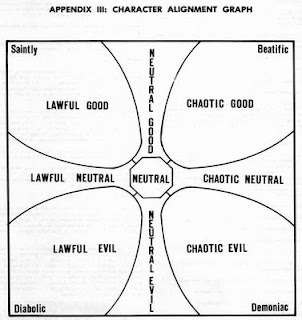"The Iron Devil"
Warlord (vol. 1) #7 (June-July 1977)
Written and Illustrated by Mike Grell
Synopsis: Morgan and Mariah, searching for Shamballah and Tara, have arrived in the city of Kiro. In the Thieves Market, Mariah draws the unwanted attention of a group of ruffians. Morgan charges to the rescue, cutting through the gang, but is caught unaware by an attack from behind, but is saved by Mariah and her rifle. The man turns, intent on putting his axe in her skull, but death catches up with him, and he dies at her feet.
The two head for the shop of the swordsmith Dak Bel Shan, who knows the secret of "Damascus steel." Morgan comissions him to make a sword for Mariah--and gives him her rifle for steel. Mariah protests, but Morgan points out the lack of stopping power of her gun, and the lack of replacement ammunition, and she agrees.
Morgan also suggests she get a Skartarian makeover to be less conspicuous. They head to the bathhouse, and, after a spa experience, Mariah emerges with Skartarian make-up, revealing outfit--and high heels.
Thanks to the story-aiding peculiarities of Skartarian time, the smith is finished. Mariah and Morgan get her sword and stiletto. Mariah surprises Morgan by revealing she's no stranger to the sword as six-time Russian National Sabre Champion. Leaving the smith, the two are ambushed and Morgan's knocked out by a blow to the skull.
Morgan awakens in a cell with Mariah. The two don't wait long before a guard comes to take time to the king. The two are escorted to the throne room, and Morgan is surprised to find Machiste there. Morgan's former oar-mate is the king of Kiro.
Machiste carries an unusual axe that never leaves his hand. He reveals he found it in a cave while on his way back to Kiro in the severed hand of a skeleton. The axe was a lucky find as it allowed him to defeat a marauding tribe of beastmen, by increasing his battle-savagery. Though the axe is now attached to his hand, Machiste is unfazed, revelling in the power he feels when he holds it. Illustrating the effect its has on him, Machiste attacks a serving girl who accidentally knocks over his drink.
Morgan intervenes and reminds Machiste of the ideals of freedom from tyranny they had previously fought for. He and Mariah move to leave, but an enraged Machiste has his guards attack them. The two make short work of them, but then Machiste challenges Morgan. The former friends wage a fierce battle, and Machiste draws first blood with a slash across Morgan's chest. Mariah pushes Morgan out of the way of the killing blow, and Machiste's axe gets stuck in the stone wall.
Before he can wrench it free, Morgan is back on his feet. A stroke of his sword removes Machiste's hand--and the influence of the axe. Machiste returns to his old self again. Morgan apologizes to his friend for what he had to do as Mariah uses a torch to cauterize the wound.
Later, a trusted Kiroan guardsman stands at the mouth of a volcano poised to destroy the axe. As soon as he removes it from the case that holds it, he becomes possessed by the weapon, and strides away purposefully from the volcano rim.
Things to Notice:
- Mariah's chained up on the cover, but not in the issue.
- One of the ruffians attacking Mariah looks kind of like Conan.
- The fashion-forward gals at the Kiro public baths give Mariah the 70s comic raccoon-eye make-up (last seen in First Issue Special #8), and Farah Fawcett hair.
- The temporal weirdness of Skartaris can serve the purposes of story.
- As noted bfore, like a lot of pulp heroes, Morgan is easily (and frequently) knocked out.
The title of this issue recalls the Robert E. Howard Conan story "The Devil in Iron," first in published Weird Tales in August 1934. The plots of the two stories share nothing in common, however.
"Kiro" may come from Cairo (from the Arabic al-Qāhira) the capital and largest city in Egypt. Another possibility is from KIRO, the designation of a radio and TV station in Seattle. Grell lives in Washington state, and moved Green Arrow to Seattle in the eighties, but I don't know whether he was acquainted with the area at the time he was working on Warlord, so the name may be a coincidence.
Damascus steel was used in sword-making in the Middle East between 1100-1700 AD. The swords produced were legendary for strength and sharpness. The exact technique used in the making of historical Damascus steel is uncertain, but Damascus steel used Wootz steel from India as a base, which is not what Mariah's rifle would be made of. What Morgan undoubtedly means with the use of the term (which is supported by the smith's description of his process on page 7) is a pattern-welding technique which can duplicate the appearance of Damascus steel. In this technique, layers of steel are combined with layers of a softer metal and folded over many times to remove impurities in the metal. By this folding a laminate is formed, and the resultant blade is more flexible for it, without sacrificing hardness.
Cursed weapons like Machiste's axe appear have a long pedigree in mythology, folklore, and literature. The Knight Balyn has a cursed sword in Le Morte D'Arthur, as does Svafrlami in the Poetic Edda. Morgan will get his own later in the series




















